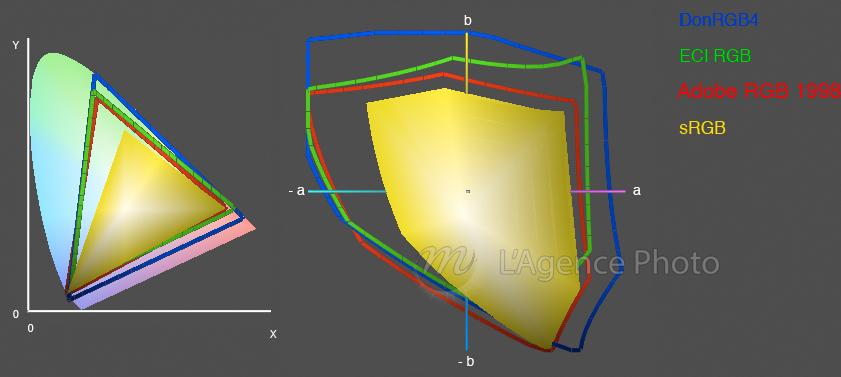Image standards
All digital files created at the Photo Agency involve the adoption of an RGB workflow across the entire graphic design process. This means that each element in the process is calibrated and characterized by its ICC (International Color Consortium) profile.
The Photo Agency has an exhaustive range of visualization and measurement equipment, software and tools that are essential to characterize each element: flatbed scanners, digital camera backs, screens, and output systems. Particular attention is also paid to colour management settings on the various types of software used, such as Photoshop, to ensure the correct visualization of the files on screen and to optimize file conversions.
Production flow:
The Agency chose an RGB production flow incorporating the colorimetric profile in the file in order to ensure:
- Greyscale balance and uniform colour rendering,
- Consistency between files from different sources (digital cameras and scanners),
- Conversion of files for multiple destinations (CMYK 1, CMYK 2, etc.),
- Combination of early binding(1) and the flexibility of late binding(2)
- Early binding: Production flow in which all colours are converted in the output colour space (CMYK) as soon as possible.
- Late binding: Production flow in which the conversion in the output colour space is delayed for as long as possible.
During digitization or in the development of the native file, the source profile is attributed to the image and a DonRGB4 conversion in 16 bits per channel is carried out.
The images are visualized, touched up and controlled in the workspace.
Choice of colour space:
The quality of the reproduction of colours and details of the works photographed depends on the choice of RGB workspace. The latter is thus of utmost importance.
Moreover, when reproducing works of art, it is essential to conserve in the digital image all the nuances of colour and the detail present in the original work.
After carrying out research and comparing different colour spaces, the Photo Agency decided to use the "DonRGB4” space.
All the digital images created by the Agency are processed in this colour space and the DonRGB4 ICC Profile is encapsulated when the files are saved.
File resolution:
File resolution has evolved a great deal since the start of digitization in 2000. The first standard image resolution was 2048 x 3072 pixels in 300 dpi. After 2004, the evolution in the number of pixels and technical equipment allowed a higher resolution of 4096 x 6144 pixels in 300 dpi to be achieved.
File resolution is constantly increasing, with the highest resolution achieved to date for a 4x5 inch image being 28400 x 34904 pixels.
The files produced by the Photo Agency range between 100 MB and 1 GB in size for the most complex montages.
Main characteristics common to all the files produced by the Agency:
- Minimum definition: 6144 x 4096 Pixels
- Resolution: 300 Dpi
- Mode: 8 Bits/Channel or Greyscale
- Colour space: DonRVB4 or Grey Gamma 2.2
- Format: TIFF or JPEG


Choix de l’espace colorimétrique :
Du choix de l’espace de travail RVB dépend la qualité de la reproduction des couleurs et des détails des oeuvres photographiées, il est donc primordial.
De plus il est absolument nécessaire dans la reproduction d’oeuvres d’art de conserver dans l’image numérique toutes les nuances de couleurs et les détails présents dans l’oeuvre originale.
Après recherche et comparaison, le choix de l’Agence Photo s’est porté sur l’espace « DonRGB4 ».
Toutes les images numériques réalisées par l’Agence sont traitées dans cet espace de couleur et le Profil ICC DonRGB4 est encapsulé au moment de l’enregistrement.

Définition des fichiers :
La définition des fichiers a très fortement évoluée depuis le début de la numérisation en 2000. Le premier standard était de 2048x3072 pixels en 300 dpi. L'évolution du nombre de stations et des équipements techniques a permis dès 2004 de passer à un standard plus important 4096x6144 pixels en 300 dpi.
La définition des fichiers ne cesse d'augmenter, la définition la plus importante obtenue aujourd'hui à partir d'un phototype 4x5 inch est de 28400x34904 pixels.
Le poids des fichiers produits par l’Agence Photographique se situe entre 100 Mo à 1Go pour les montages les plus complexes.
Caractéristiques principales et communes à tous les fichiers produits par l’Agence :
- Définition minimum : 6144x4096 Pixels
- Résolution : 300 Dpi
- Mode : 8 Bits/Couche ou Niveaux de gris
- Espace : DonRVB4 ou Gris Gamma 2,2
- Format : TIFF ou JPEG
